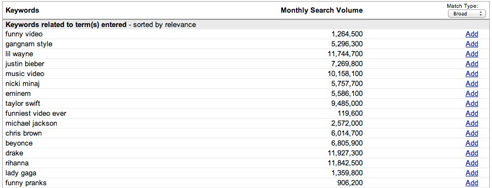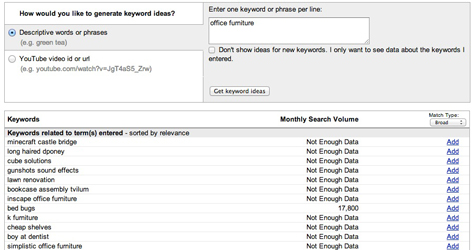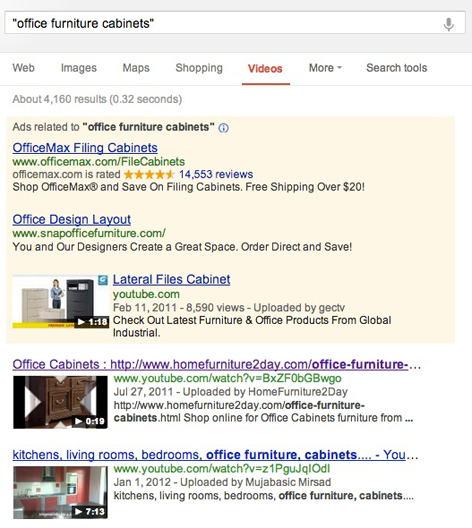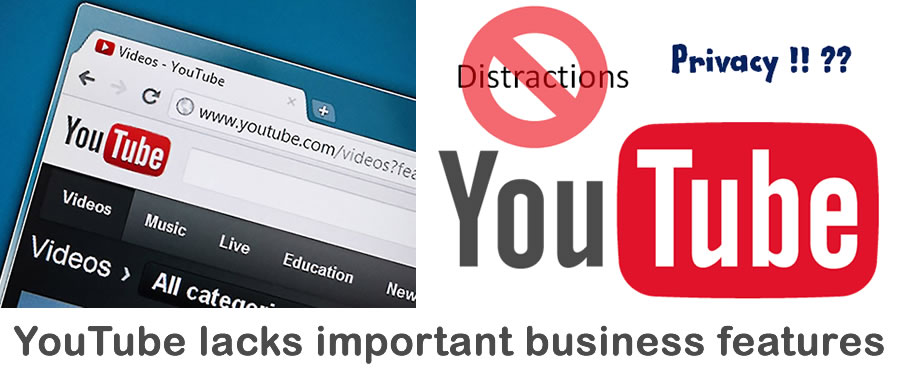So, here’s the deal. YouTube is free. While technically mis-labeled as the second largest search engine behind Google itself, YouTube still gets a TON of searches. It’s fairly easy to create a channel and upload videos. Why in the world would you want to use something else? And why would you pay for it?
Here are five reasons why you shouldn’t care about the video-sharing monster and why you should take your video somewhere else (teaser: we’ll look at why you should care at the end):
1. Most people aren’t searching for what you’re selling on YouTube.
Let’s do some keyword research.
Jumping over to YouTube’s little known keyword tool (beta), and entering the term “video” (generic, so we can get some broad suggestions of what people are looking for) shows us these results:

Notice the monthly search volume on:
- “music video” – 10 million
- “lil wayne” – 11 million
- Drake – 12 million
Now, if you’re Lil Wayne or Drake, you’re very happy with this. But what if you’re an office furniture company who wants to show a video to people of how convenient and useful your new personal desk cabinets are? Let’s search for office furniture:

Pretty much no one is searching for office furniture on YouTube, according to their own keyword placement tool. Huh.
What if we head to Google’s keyword research tool?

Whoa. There are 1,500,000 global monthly searches for “office furniture”. Okay, we probably will have a hard time penetrating that. But what about “office furniture cabinets?”

Ah. 14,800 results. Now that’s a manageable result to get into, and 14,800 more opportunities here than “not enough data” on YouTube.
2. Not many people are using video in the first place. Even fewer are sending people directly to their website.
Let’s take a look at what happens when we search video results for “office furniture cabinets”.


We’re seeing seven video results, all of them sending people to off-site video sharing platforms. Looking at the top results from homefuniture2day.com, it’s nice that they’re there, and they were at least savvy enough to include a link to their site in the description of their video, but I still have to watch the video and like it enough to actually click the link to their site.
Wouldn’t it be better for me to go straight to their site, and perhaps, even if the video isn’t stellar, I’ll be interested in browsing through their other products?
Using a self-hosted video platform can allow us to include our video in what’s called a video site map, which gets indexed by Google just like any other page of a website, effectively allowing our video to show up not only in video results but, with the right tactics, in the first page of the general search results!
3. YouTube statistics are only so great.
We base our success on the fact that if we can’t measure it, we don’t do it. So, we want to be sure we can successfully measure video. When looking at analytics for a video on YouTube, we can see these things:
- “Performance” – Number of views.
- “Estimated Minutes Watched” – Yes, only estimated.
- Audience Retention – This one is good, and very, very helpful.
- Traffic Sources – Great, except for when it’s not, and tells you “unknown sources”.
While this information is incredibly important, especially “audience retention,” a statistic anyone with any video that’s important to them should be paying attention to, it only goes so deep.
With a third-party self-hosted video platform like Wistia (we LOVE Wistia) you can get everything above, and even better:
- Actual minutes watched
- Actual engagement rate (percentage of people who watched 100%)
- Detailed heatmaps per viewer (where they watched, rewatched, or didn’t watch)
- Individual viewer anonymous IP information
- Individual viewer information based on an email address tied to features in the platform
- All of the specific places the video was viewed (including on site and off-site)
4. YouTube will un-brand you.
Uploading a video to YouTube alone will cause your video to automatically have the YouTube brand skinned on to it. It’s red and black with a YouTube logo no matter what. Secondly, unless the video is embedded on your own site and you leave the “show suggested videos” box unchecked, you WILL get recommended videos at the end of a video that you have no control over. This can be particularly concerning if your videos have even a tiny bit of potential to be related to something inappropriate for your business or audience.
A video hosting service will offer everything opposite of the above, such as:
- Complete branding of the player (button colors, logos, etc.)
- Completely custom thumbnails, based on a screenshot of the timestamp or even a nicely-designed jpeg
- No related videos or advertisements on any videos
5. YouTube lacks important business features.
Wistia and other platforms allow you to integrate some amazing business tactics right into embedded videos:
- Email capture (before or after a video, even required to watch, if you like)
- Calls to action after videos (text, image, or custom html)
- Built-in event tracking that passes through to Google Analytics
- Responsive embedded video
- Email marketing integration with most of the major email service providers
Another very important feature is that you get to choose how your video is shared (email, FB, Twitter, LinkedIn, etc.) and when it is shared. If someone clicks back to the original video, they head to your website, not to YouTube.
Why You SHOULD Care About YouTube
In my opinion, everyone who owns a business and wants to actually drive traffic to their site through video, wants more control over their branding, and wants more business features should not be using YouTube for their main video strategy. After all, most business video is likely not going to get millions or even thousands of views. And Wistia offers their platform completely free for the first three videos.
However, there is one major reason to use YouTube for the right videos: advertising.
Google’s new model for video advertising using TrueView is that you only pay if someone watches 100% of a 15- or 30-second video. So, even if someone watches 75% of your video and clicks over to your site, that watch and click is completely free. Plus, Google has a wealth of demographic information that can be used for targeting as well as a large network of sites that can show video. While you could spend hours and hours using an outreach program to find places to embed your videos, Google’s Display Network can put your video in the right spot and in front of the right viewership very quickly.
When Hosting Your Own Video Can Cause You To Move It To YouTube
One other reason to use YouTube is to encourage the spread of a “viral” video. You can’t predict that your video will go viral. You could use various formulas to create viral video that are out there, but you just can’t force those things without a whole lot of positive variables working to your advantage. However, if a video you host yourself through a third-party hosting platform starts to go crazy with viewership and embeds, it might not be a bad idea to put a copy on YouTube, make sure it’s optimized and linked back to your site, and let it go.
Article source and credit!







Recent Comments